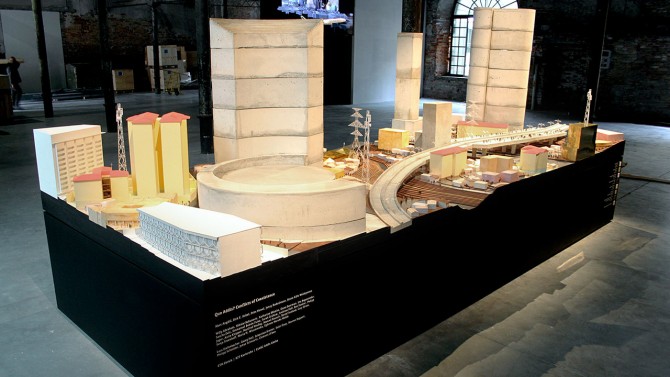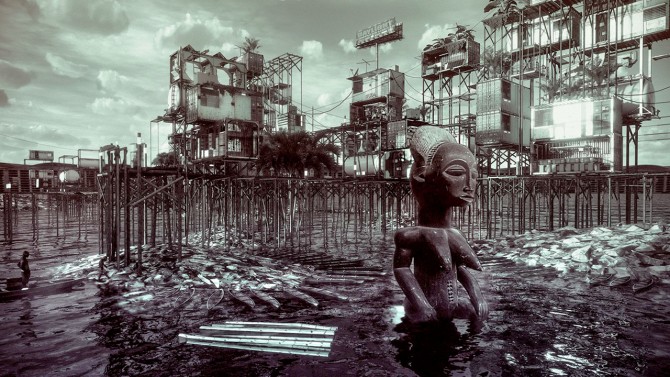Faculty, alumni and a doctoral candidate in the College of Architecture, Art and Planning's Department of Architecture are answering a key question at the 2021 Venice Biennale: "How will we live together?"
That question - the theme of the exhibition - is as much a social and political question as a spatial one. "We need a new spatial contract," writes curator Hashim Sarkis. "In the context of widening political divides and growing economic inequalities, we call on architects to imagine spaces in which we can generously live together."
The 17th International Architecture Exhibition is part of the larger Venice Biennale - La Biennale di Venezia - a massive juried international exhibition of arts and design held every other year in Venice, Italy.
Originally scheduled for 2020 and postponed by the pandemic, the biennale runs May 22-Nov. 21.
Installation view of Esra Akcan's 2019 exhibition, "Open Architecture: A Book on Migration," at the College of Architecture, Art and Planning's John Hartell Gallery.
Esra Akcan, Michael A. McCarthy Professor of Architectural Theory, and director of European Studies in the Einaudi Center for International Studies, contributed to the main catalog with her essay, "Architecture in the Age of Migrations." As a reflection of her book "Open Architecture," she wrote, "We live in the century of migrations." She calls on architects who are committed to justice and diversity to respond with open architecture and to give examples of latent open architecture in history that one could build upon - examples that reveal immigrants' ability to make places and worlds despite all difficulties.
Sara M. Anwar, B.Arch '02, is the curator of the Pakistan Pavilion, which explores "shadi" (marriage) halls as a type of architecture of post-partition Pakistan. Over time, the halls have transformed to colonial domestic villas as an organic response to urban and social needs.
The Pakistan Pavilion houses a digital exhibition and interactive interface, "Mapping Festivities," consisting of video, data visualization, architectural documentation, critical essays and tarot cards. The exhibition operates at the scale of the city, the street and the wedding venue, mapping supply chains, community networks and the wedding venues as sites for performance. These sites act as egalitarian spaces in the city that allow different industries, communities and social classes to coexist. Andrea Simitch, the Stephen H. Weiss Presidential Fellow and chair of the Department of Architecture, will provide editorial assistance on a planned exhibition catalog intended to include a series of drawings and Cornell student contributions.
This image is from "The Commons," a video installation co-created by Alessandra Cianchetta, visiting critic, which explores the contemporary notion of the landscape commons through images of deserts.
Visiting Critic Alessandra Cianchetta's works are part of exhibits, installations and pavilions this year. "The Commons," a video installation she made with James Melsom of LANDSKIP, explores the notion of "die Allmende" - the landscape commons - through images of deserts shot across continents during the pandemic year. It is part of the exhibit "Future Assembly," a "collective exhibition within the exhibition" reflecting on the 75-year history of the United Nations Charter. Cianchetta's work is also featured in a site-specific sculpture installation, "Fields of Line," with Viennese artist Sonia Leimer, located at Forte Marghera site. And her built projects are part of the Italian and Cyprus pavilions.
Detail view of "Quo Addis: Conflicts of Coexistence," a fictional reimagining of Addis Ababa, by Felix Heisel, assistant professor of architecture, and Marta H. Wisniewska, lecturer in architecture, and their collaborators.
Felix Heisel, assistant professor of architecture, and Marta H. Wisniewska, lecturer in architecture, are part of the collaborative interdisciplinary team for Addis Ababa. Their installation, "Quo Addis: Conflicts of Coexistence," is a fictional model of the Ethiopian capital city consisting of multiple layers, each representing a particular political regime whose traces remain in Addis Ababa. The regimes range from the Age of Empire to occupation, European-sponsored modernization, the USSR-backed socialist regime, and contemporary megadevelopment ventures sponsored by foreign actors. A final layer focuses on alternative ways the people of Addis Ababa might live together in the future.
Samia Henni, assistant professor of architectural theory and history, contributes essays to two exhibition catalogs: "The Ruins of the Present," in the main catalog, and "Deserticide: 'Oil Lakes' as Archival Violence," in the Kuwait Pavilion catalog. Her essays are based on her research on the built environments in relation to colonialism, displacement, gender, Islam, and wars from the first European colonization to the present. She also draws on her books, including "Architecture of Counterrevolution: The French Army in Northern Algeria" (2017), and her work as the curator of the travelling exhibition "Discreet Violence: Architecture and the French War in Algeria (2017-19)."
An image from "Liquid Geographies, Liquid Borders" by Olalekan Jeyifous, B.Arch '00, and Mpho Matsipa. The central figure represents Yemoja, the Yoruba goddess of the sea.
The work of Olalekan Jeyifous, B.Arch '00, and Mpho Matsipa appears within "Across Borders" at the Central Pavilion. "Liquid Geographies, Liquid Borders" explores the landscape of the lagoon as a spatial metaphor for complex, slippery exchanges that seek to delineate ownership, but also gestures toward a terrain of aquatic ecologies. This fluid, imaginary space that connects the Niger delta to other waterways emerges at the interface of aquatic ecologies and multiple representations of Yemoja, the Yoruba goddess of the sea. Taking crude oil-spills as a point of departure, the installation connects oil-fueled trade and degradation with these landscapes that take on many forms. Yemoja introduces not only oral histories and culture to the discourse on oil, but also an ecofeminist, deeply rooted critique of oil culture.
Maria Luisa Palumbo, Ph.D. '25, organized a roundtable, "Europe, a Resilient Community? Critical Practices across the Mediterranean Border," for the Italian Pavilion on May 23. The panel, which included Henni, offered female scholars and architects the opportunity to examine how the Mediterranean Sea and its shorelines have been shaped by the migratory movement of people fleeing Africa to reach the European Union, and the countermovement of European Union civil, legal and military operations patrolling the Mediterranean to "secure" EU borders. The discussion centered on the paradoxes of the border's militarization and considered alternative practices and design strategies for a resilient future.
To purchase tickets for the Venice Biennale of Architecture and to view the agenda of events, openings and activities, click here.
Patti Witten is a writer for the College of Architecture, Art and Planning.










